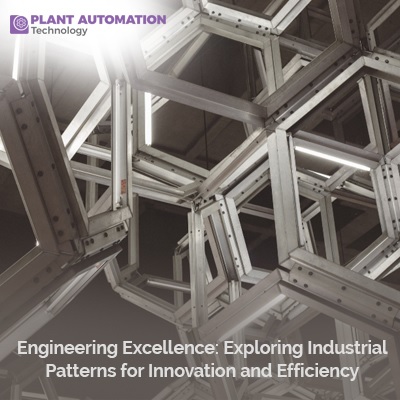Engineering Excellence: Exploring Industrial Patterns for Innovation and Efficiency

In the dynamic landscape of industrial engineering, patterns emerge as crucial elements that shape processes, enhance innovation, and drive efficiency. These industrial patterns, ranging from design principles to operational strategies, play a significant role in achieving engineering excellence across various sectors. In this comprehensive article, we delve into the realm of industrial patterns, exploring their importance, application, impact, and future trends.
I. Understanding Industrial Patterns
Industrial patterns encompass a wide array of concepts and practices that contribute to the optimization of industrial processes. These patterns are rooted in principles of design, production, quality management, supply chain optimization, and technological integration. They serve as blueprints for achieving consistency, reliability, and effectiveness in industrial operations.
One of the fundamental aspects of industrial patterns is their adaptability across different industries. Whether it's manufacturing, logistics, energy, healthcare, or automotive sectors, the core principles of industrial patterns remain applicable, albeit with tailored implementation strategies.
II. Key Elements of Industrial Patterns
Design for Manufacturing (DFM): DFM is a fundamental industrial pattern that focuses on designing products in a way that optimizes manufacturing processes. By considering factors such as material selection, assembly methods, and production efficiency during the design phase, DFM ensures cost-effective manufacturing and high-quality end products.
Lean Manufacturing Principles: Lean manufacturing is built on the principles of minimizing waste, optimizing production flow, and continuous improvement. Industrial patterns derived from lean methodologies include Just-In-Time (JIT) manufacturing, Kanban systems, value stream mapping, and Kaizen practices, all aimed at streamlining operations and maximizing value.
Six Sigma Methodology: Six Sigma is a data-driven approach to quality management and process improvement. Industrial patterns derived from Six Sigma include DMAIC (Define, Measure, Analyze, Improve, Control) and DFSS (Design for Six Sigma), which enable organizations to identify defects, reduce variability, and enhance overall process performance.
Supply Chain Optimization: Industrial patterns in supply chain management focus on optimizing inventory levels, minimizing lead times, improving supplier relationships, and leveraging technology for real-time visibility and coordination. Concepts such as Just-In-Time inventory, vendor-managed inventory (VMI), and collaborative planning, forecasting, and replenishment (CPFR) are integral to efficient supply chain operations.
Smart Manufacturing and Industry 4.0: The advent of Industry 4.0 has brought forth industrial patterns centered on digitalization, automation, and connectivity. Concepts like the Internet of Things (IoT), Artificial Intelligence (AI), Big Data analytics, and cyber-physical systems (CPS) are driving the evolution of smart manufacturing, enabling predictive maintenance, real-time monitoring, and data-driven decision-making.
III. Impact of Industrial Patterns
The adoption of industrial patterns yields numerous benefits across industries:
Improved Efficiency: Industrial patterns streamline processes, reduce waste, and optimize resource utilization, leading to enhanced operational efficiency.
Enhanced Quality: By incorporating quality management principles, industrial patterns contribute to delivering products and services that meet or exceed customer expectations.
Cost Reduction: Through lean practices, process optimization, and supply chain efficiencies, industrial patterns help organizations minimize costs and improve profitability.
Innovation Acceleration: Industrial patterns foster a culture of continuous improvement and innovation, driving technological advancements and competitive differentiation.
Sustainability: Many industrial patterns emphasize sustainability practices, such as eco-friendly manufacturing processes, waste reduction, and energy efficiency measures, contributing to environmental stewardship.
IV. Future Trends in Industrial Patterns
Looking ahead, several trends are shaping the landscape of industrial patterns:
Digital Twin Technology: Digital twins, virtual replicas of physical assets or processes, are revolutionizing industrial patterns by enabling simulation, optimization, and predictive maintenance.
Additive Manufacturing: Industrial patterns are evolving with the widespread adoption of additive manufacturing (3D printing), offering new possibilities in rapid prototyping, customization, and supply chain decentralization.
Blockchain in Supply Chain: Blockchain technology is poised to transform supply chain patterns, enhancing transparency, traceability, and trust among stakeholders.
Human-Machine Collaboration: Industrial patterns are increasingly focused on human-machine collaboration, leveraging AI, robotics, and augmented reality to enhance productivity and decision-making.
Circular Economy Practices: Industrial patterns promoting circular economy principles, such as product reuse, remanufacturing, and recycling, are gaining traction for sustainable resource management.
V. Emerging Challenges and Strategies in Industrial Patterns
While industrial patterns offer substantial benefits, they also come with challenges that require innovative strategies for mitigation:
Cybersecurity Concerns: As industrial systems become more interconnected and data-driven, cybersecurity threats loom large. Industrial patterns must incorporate robust cybersecurity measures, including encryption, access control, and threat detection, to safeguard critical assets and information.
Skills Gap and Training Needs: The rapid evolution of technology demands a skilled workforce capable of implementing and optimizing industrial patterns. Organizations need to invest in continuous training and upskilling programs to bridge the skills gap and harness the full potential of industrial innovations.
Supply Chain Disruptions: Global events such as pandemics, natural disasters, geopolitical tensions, and trade disruptions can severely impact supply chains. Industrial patterns should include resilience strategies such as diversification of suppliers, inventory buffers, and agile response mechanisms to mitigate supply chain disruptions.
Regulatory Compliance: Compliance with regulatory standards and industry norms is paramount in industrial operations. Industrial patterns should integrate compliance requirements seamlessly into processes, ensuring adherence to quality, safety, environmental, and ethical standards.
Environmental Sustainability: With increasing focus on environmental sustainability, industrial patterns must prioritize eco-friendly practices, renewable energy adoption, waste reduction, and carbon footprint mitigation. Circular economy principles and sustainable supply chain practices play a vital role in achieving environmental objectives.
VI. Case Studies and Success Stories
Several organizations have successfully implemented industrial patterns to achieve remarkable outcomes:
Toyota Production System (TPS): Toyota's lean manufacturing principles, part of the TPS, have revolutionized automotive manufacturing by optimizing production processes, reducing waste, and enhancing quality. TPS serves as a benchmark for lean practices globally.
Amazon's Supply Chain Management: Amazon's advanced supply chain management practices, including predictive analytics, robotics integration, and efficient logistics, exemplify cutting-edge industrial patterns that enable rapid delivery, inventory optimization, and customer satisfaction.
Siemens' Digitalization Initiatives: Siemens has embraced digitalization and Industry 4.0 concepts, leveraging digital twins, AI, and IoT to transform its manufacturing operations. These industrial patterns have resulted in improved productivity, predictive maintenance, and innovation acceleration.
Tesla's Innovation in Electric Vehicles: Tesla's innovative approach to electric vehicle manufacturing, incorporating advanced robotics, battery technology, and software integration, showcases industrial patterns driving disruptive innovation and sustainability in the automotive industry.
Conclusion: Pioneering the Future of Industrial Excellence
Industrial patterns are at the forefront of engineering excellence, driving innovation, efficiency, and sustainability across industries. By addressing emerging challenges, leveraging advanced technologies, nurturing talent, and embracing best practices, organizations can pioneer the future of industrial excellence and thrive in a dynamic global landscape. Through continuous adaptation, optimization, and collaboration, industrial patterns will continue to shape the evolution of industry, unlocking new possibilities and driving transformative change.







